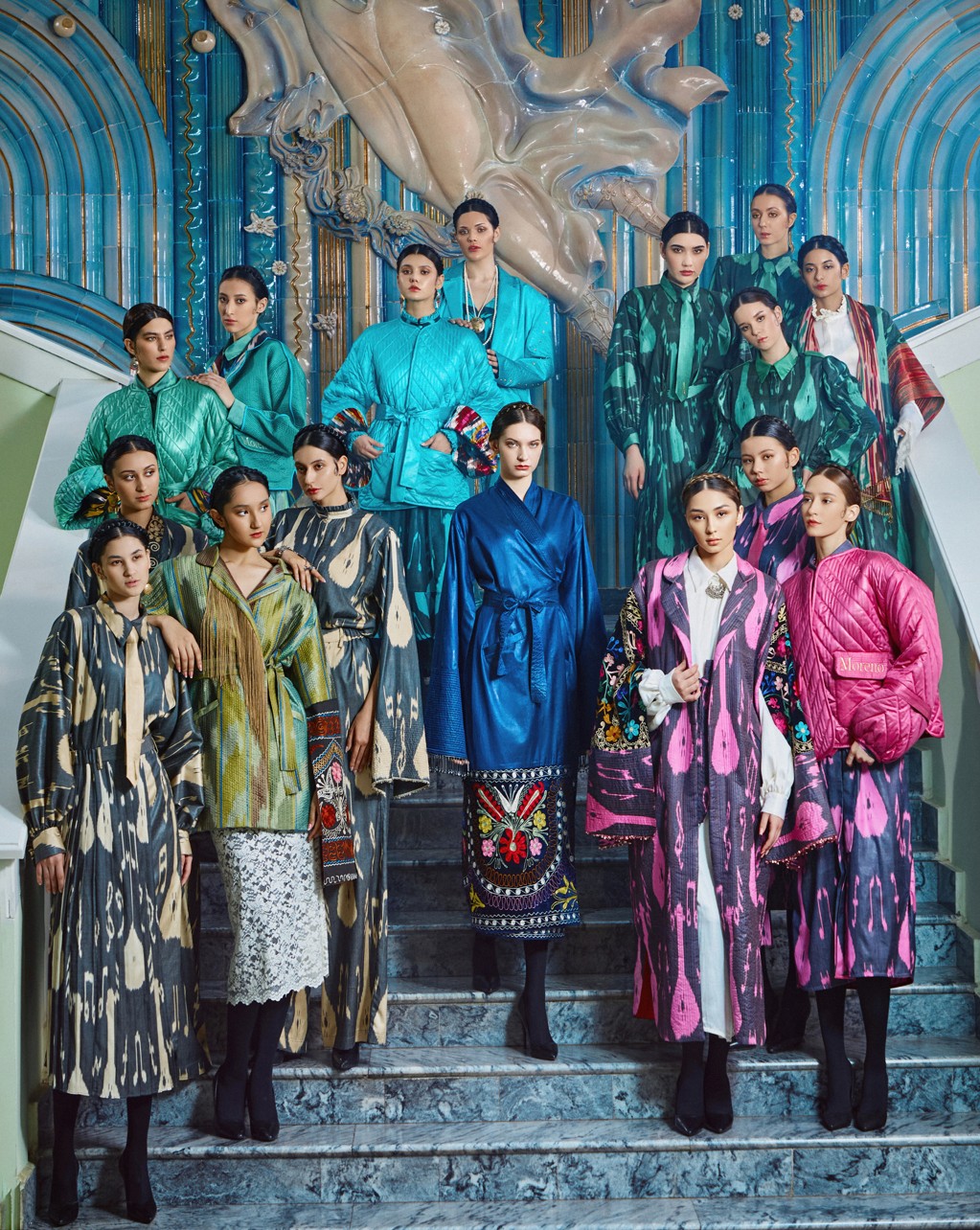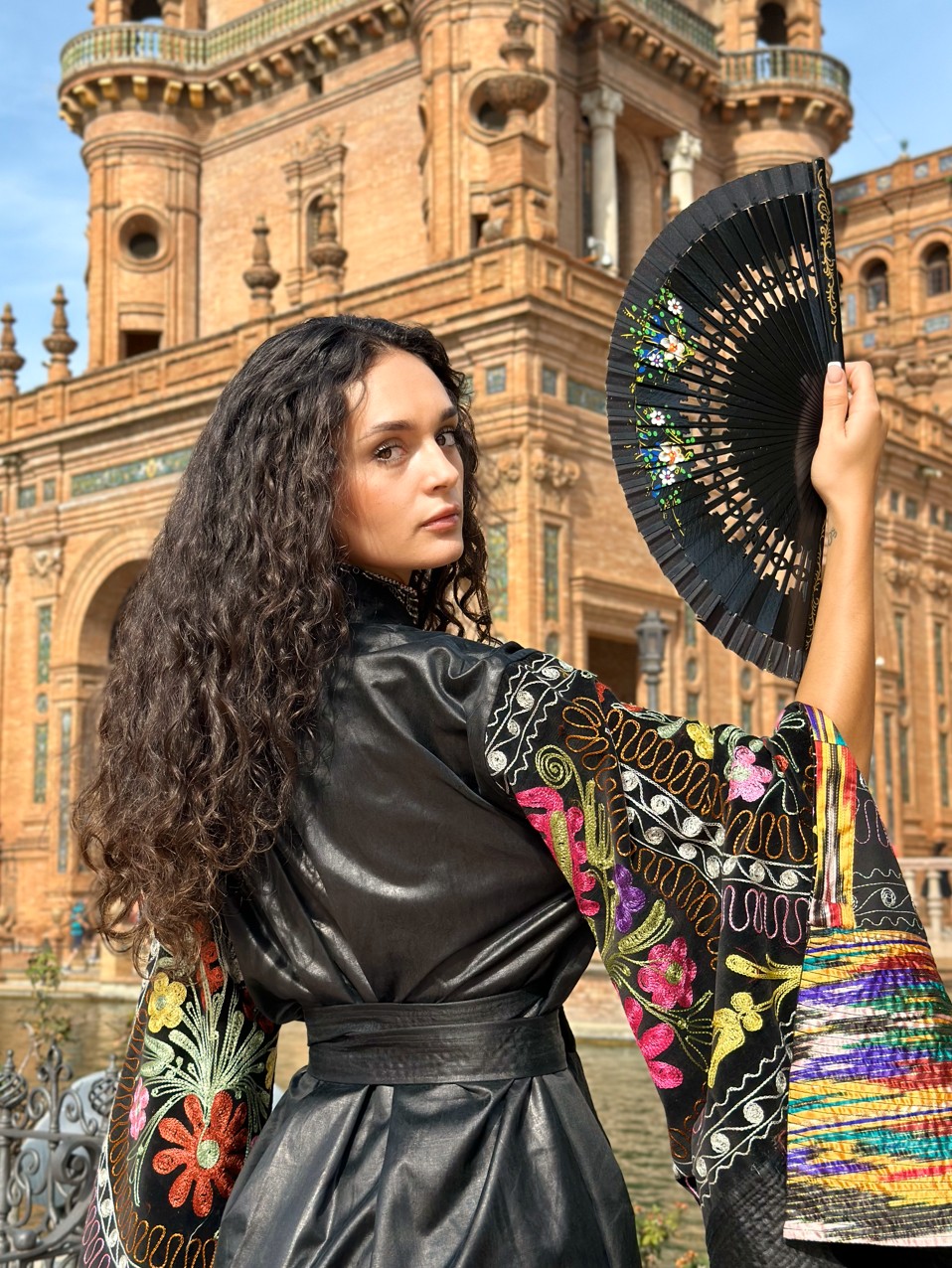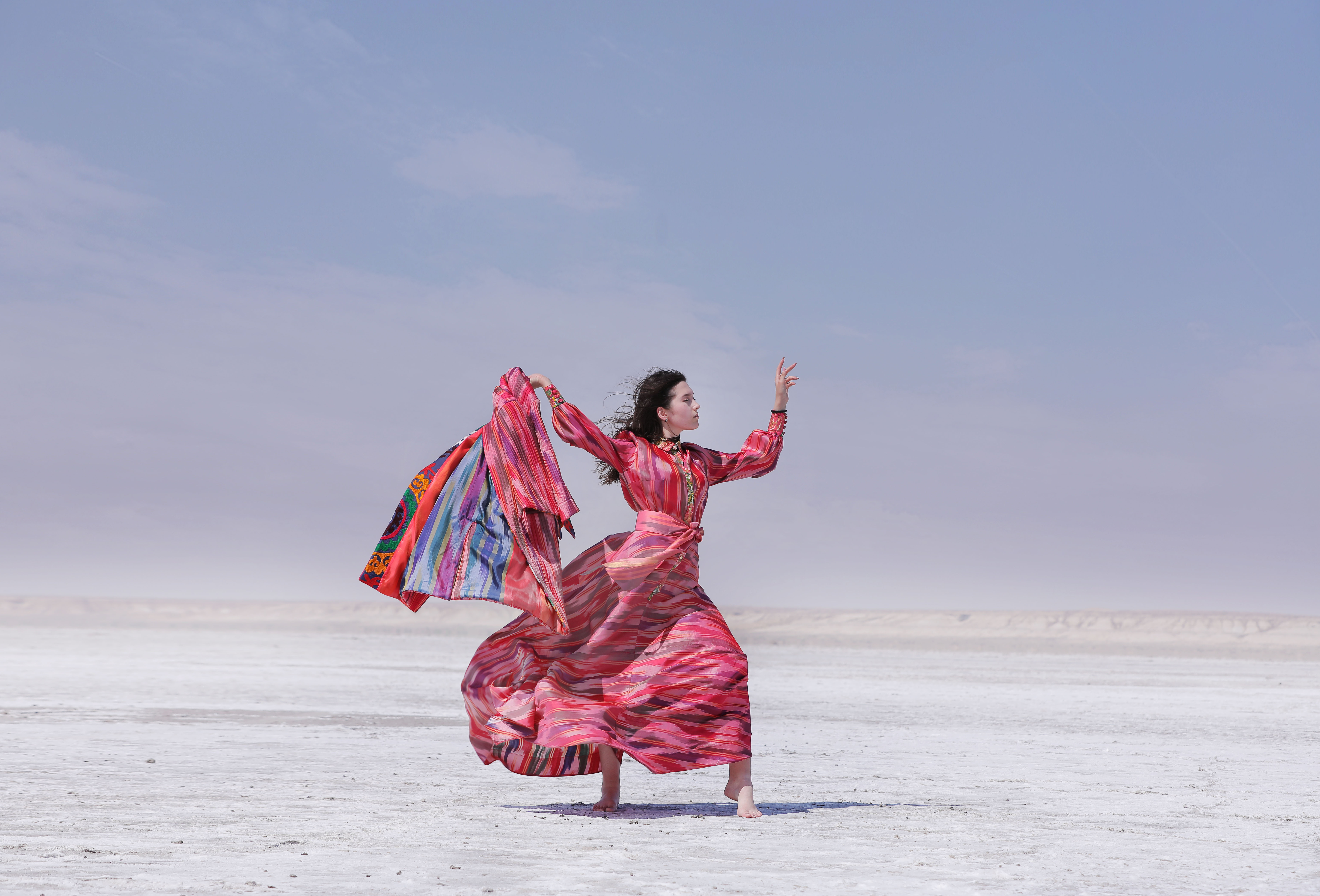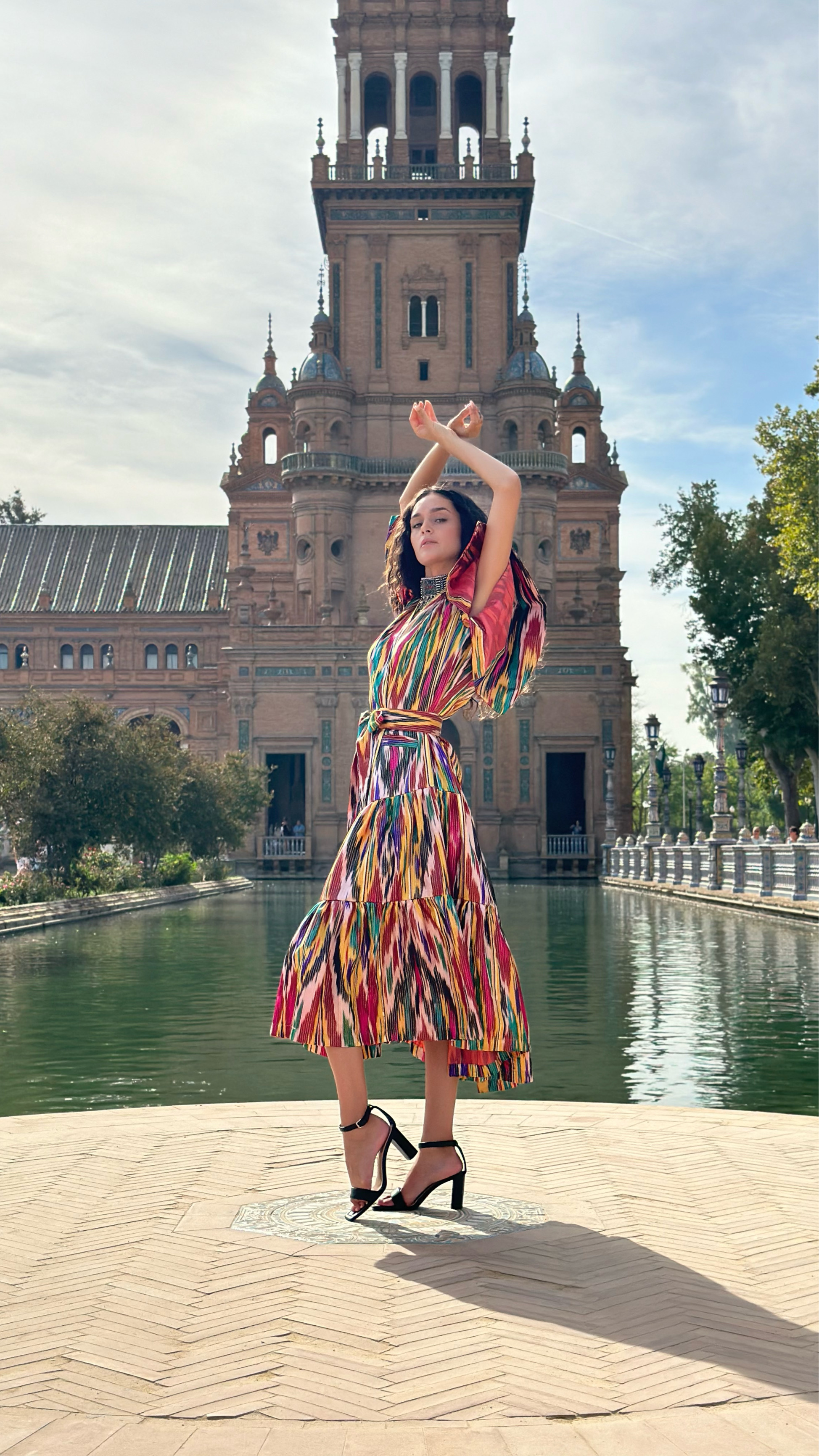
Culture • 26 May, 2025
Azukar Moreno: an uzbek brand with a spanish accent
Our conversation with Kamola Rustamova, founder of the Uzbek clothing and accessories brand Azukar Moreno, took place in between her preparations for the Visa Fashion Week Tashkent 2024 and her trip to London. Kamola releases her own collections twice a year, distinguished by the fusion of traditional ikat fabric with modern prints. Today, Azukar Moreno is the only national brand represented in the Duty Free zone of Tashkent International Airport named after Islam Karimov.
Naturally, our conversation mainly centered around travel: Kamola shared her favorite vacation spots, what she enjoys doing on planes, and where she finds inspiration.
About the Brand
Azukar Moreno is a women's clothing and accessories brand with a showroom located in the Navruz Ethno Park in Tashkent. Its founder, Kamola Rustamova, studied in Spain and was named the best young designer of Andalusia in 2007 and of Madrid in 2012. She has worked with renowned fashion houses such as Max Mara, Jimmy Choo, Victorio & Lucchino, Purificación García, and Carolina Herrera, as well as the Inditex Group. She has also participated in fashion shows across Uzbekistan, Europe, and South America. Today, Azukar Moreno offers not only clothing but also shoes, bags, accessories, and headwear to complement its collections. However, the brand’s signature quilted jackets remain its most popular item. Every garment includes a unique element—a kind of message meant to emphasize the individuality of each woman. Kamola’s creations are in such high demand that in May 2024, the showroom had to temporarily close due to the complete sell-out of its inventory, allowing the team to focus on designing a new collection. – Kamola, tell us how you came up with such an unusual name for your brand. – In 2004, when I was 20, I moved to Madrid to study design. I arrived without knowing the language, and to adapt quickly, I was advised to work as a nanny. The four-year-old boy I cared for called me “azúcar,” which means “sugar” in Spanish. The second word, “morena,” in Spain refers to a tanned brunette woman. The combination of these words became the brand name.
– How did your family react to the news that you were moving abroad to study?
– Of course, it’s not typical in our culture for a young, unmarried girl to travel alone to another country. Spain felt like a dark forest to me at the time, especially since there were no messengers or social networks to stay in touch. We corresponded with my parents through letters. But I’m sure it was the best decision of my life — a choice that shaped my future. Most importantly, my parents supported me, gave me freedom, and didn’t interfere with my decisions.
– We know you had a major project in Spain. Could you tell us more about it? – Yes, many of my projects were and still are created outside of Uzbekistan. One of my favorite and most ambitious projects was preparing 4,000 costumes for a parade in Spain. The entire process took four years! While not all, a large portion of the costumes were sewn in our workshop. The complexity of the project lay in its scale across Uzbekistan: fabrics were woven in Margilan, embroidery was done in Bukhara, Navoi, Samarkand, and Tashkent, and a family dynasty in Kokand made the jewelry. One unforgettable costume was made entirely of metal — it took a whole year to complete. Importantly, this project helped many local artisans survive during the pandemic, when orders had stopped and everyone was stuck at home. – You’ve traveled to many countries. Which ones are your favorites? – After Uzbekistan, Spain is dearest to me because I studied, lived, and took my first design steps there. I actually love every country I’ve visited. I’ve been warmly welcomed everywhere and made friends and connections. But perhaps the most memorable places are in Latin America. I love destinations near seas and oceans — even though I can't swim, I would love to live by the shore. I also enjoy big cities where I can walk for hours and disappear into the crowd, like in Milan. I love observing people passing by. This way, I don’t spend energy on socializing but instead draw energy from my surroundings. I’m drawn to the power of megacities with skyscrapers, where you wake up early and rush out for coffee and a donut to start a busy day. But in nature, I recover quickly and catch up on rest — until the pulse of the city calls me back again. – What in your travels inspires new ideas? – I’m inspired by new places, people, and experiences I’ve never had before. It could be an old Italian restaurant, a scene at a neighboring table, music playing in the background, or a view from a window. For example, my “Anchor” collection was inspired by Valencia. In 2022, at a sea-themed event, food was served in seashells that were meant to be discarded. As someone who’s mindful of nature, I couldn’t let them go to waste — I brought them back to Uzbekistan. I was also drawn to a lifebuoy with a blue decorative anchor I saw on the beach. That’s how I came up with the idea for an ikat fabric with anchor patterns, woven in Margilan based on my sketch. The collection was so popular that even a year later, people still ask for items with that design. The anchor has become our signature — a symbol of stability and a woman who stands firmly on her feet with endless potential. Right now, we’re working on a collection inspired by Lisbon. The idea came while I was watching young people singing and dancing in a public square. This tropical collection, infused with Latin American flair, aims to recreate the spirit of celebration. By the way, a client recently told me that while walking through Seville, she recognized my concepts everywhere and understood the essence behind my collections. I’m proud that I can share the emotions of my favorite places through my work. – You use vintage fabrics and accessories in your collections. Where do you find them? – I’ve always used vintage materials, but as the trend grew in popularity, I began to lose interest. I noticed I was being copied — people with access to similar fabrics could easily replicate ideas I had poured my time, knowledge, and effort into. Now I’m more interested in creating collections with custom-designed fabrics. We collaborate with weavers in Margilan, buying looms and training artisans. To prevent imitation, even if I don’t buy the entire batch of fabric, we print my logo onto it — making it clear who the creator is. There have even been cases where I was accused of plagiarizing my own work. In our latest collection for Visa Fashion Week Tashkent 2024, the logo became a key element: the name “Azukar Moreno” was woven directly into the ikat pattern. This spring, we released scarves featuring the brand name — a first in ikat history. As for vintage, I love collecting antique trims from around the world. I have beautiful lace from Russia, Ukraine, Belarus, Romania, and Valencia. From the Istanbul flea market, I brought coins, jewelry, and vintage mother-of-pearl buttons. I often buy in Paris — tapestry, lace, and last year, I even found interesting burlap. I also source antique embroidery and trims from collectors in Kokand. Occasionally, I visit Tashkent’s Yangiabad market, though sadly, there’s very little left now. – In interviews, you often mention your eco-conscious approach to business. Even your Instagram bio says fashion and ecology can coexist. What do you mean by that? – Textile production is one of the world’s leading causes of pollution. Our sustainable approach includes zero-waste production and the use of natural fabrics. But not all natural materials are environmentally friendly for the planet or people. We try to use silk threads and cotton grown in small batches without pesticides. Our fabrics are handwoven, which greatly reduces emissions compared to industrial manufacturing. To us, “sustainable fashion” also means preserving Uzbekistan’s traditions and culture and respecting the craftswomen who do so much by hand. – Tell us about your photo shoot at the Aral Sea. Why there, and what was the message behind it? – The Aral Sea shoot was special to me. It visually highlighted the harm humanity has done to the planet. The drying of the Aral Sea is a global tragedy. The winds are so strong there that toxic dust has been found as far as Norway. And yet, the environment remains inspiring. It was the most beautiful and extreme shoot I’ve ever done. We couldn’t stay in the area for more than an hour due to radiation and fierce storms. My team got lost several times, and after a tire burst, we were stranded for six hours in 60°C heat, then froze at night without water. That was actually my birthday — and the most unforgettable one. – Our readers are flying with Centrum Air right now. Tell us, what do you usually do during flights? – I used to watch movies I hadn’t had time for, clean up my phone, look through photos, and even sew. Once, flying to Malaysia with a collection, I was finishing pieces by hand on the plane. Lately, I just want to fly, relax, and disconnect — no phone, nothing. – Do you prefer to travel light or with a lot of luggage? – I love traveling light, but it’s only happened twice in my life — like when I recently went to Madrid with just a small suitcase. I especially enjoyed not waiting for baggage at the airport, though I did come back with a new suitcase after some shopping. Usually, I take lots of items from my collections because I want to photograph them in beautiful locations to show how they look against real-life backdrops and architecture. – What would you recommend to first-time visitors in Tashkent? – I recommend everyone visit the Navruz Ethno Park. You’ll enjoy beautiful architecture, traditional houses, and a nostalgic atmosphere. For example, our showroom is located in a house that we restored while preserving its historic spirit. Also, explore the city’s parks and bazaars, and be sure to try the national cuisine. Many of my friends once considered it too heavy — but after tasting it, they always leave satisfied.


